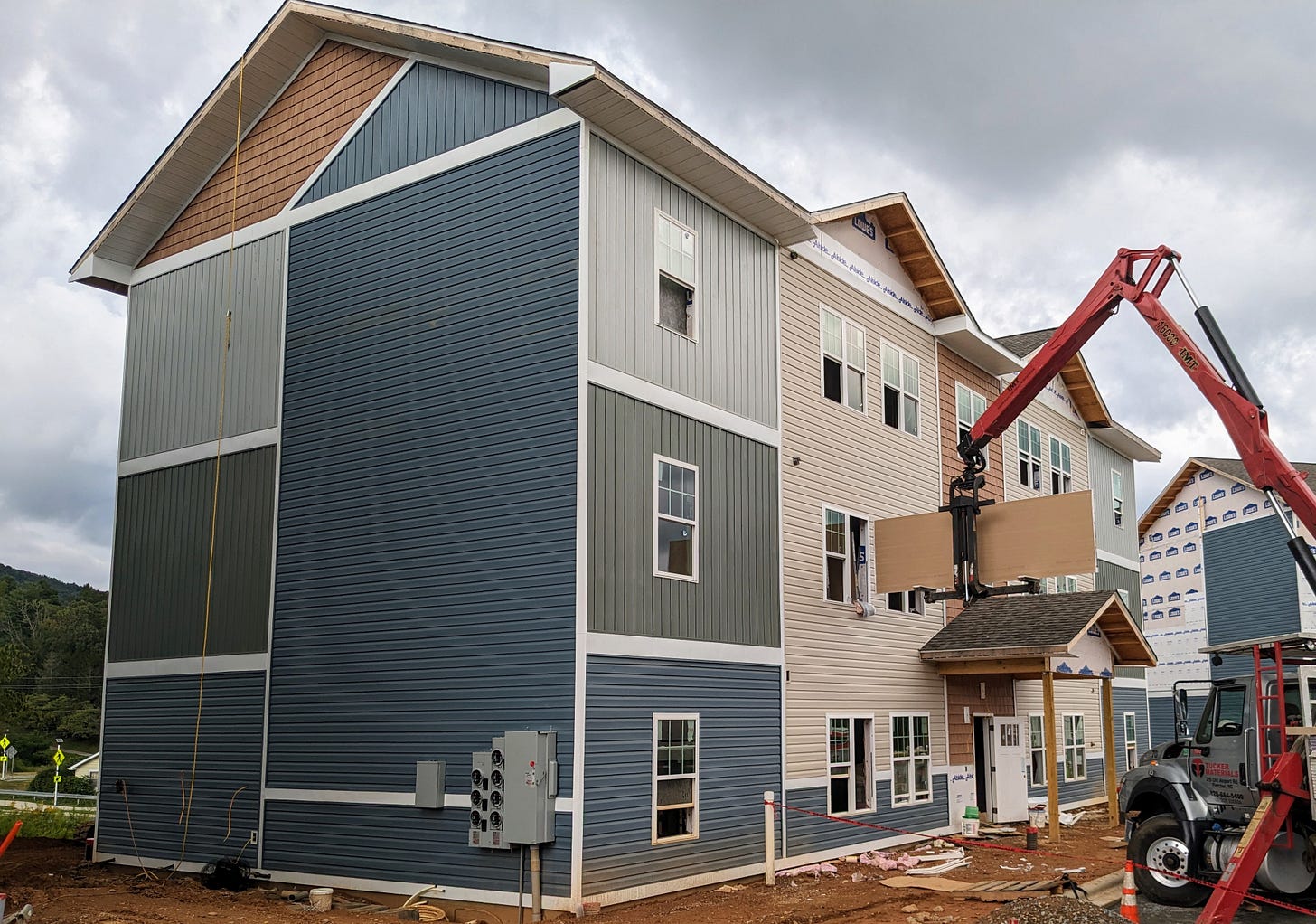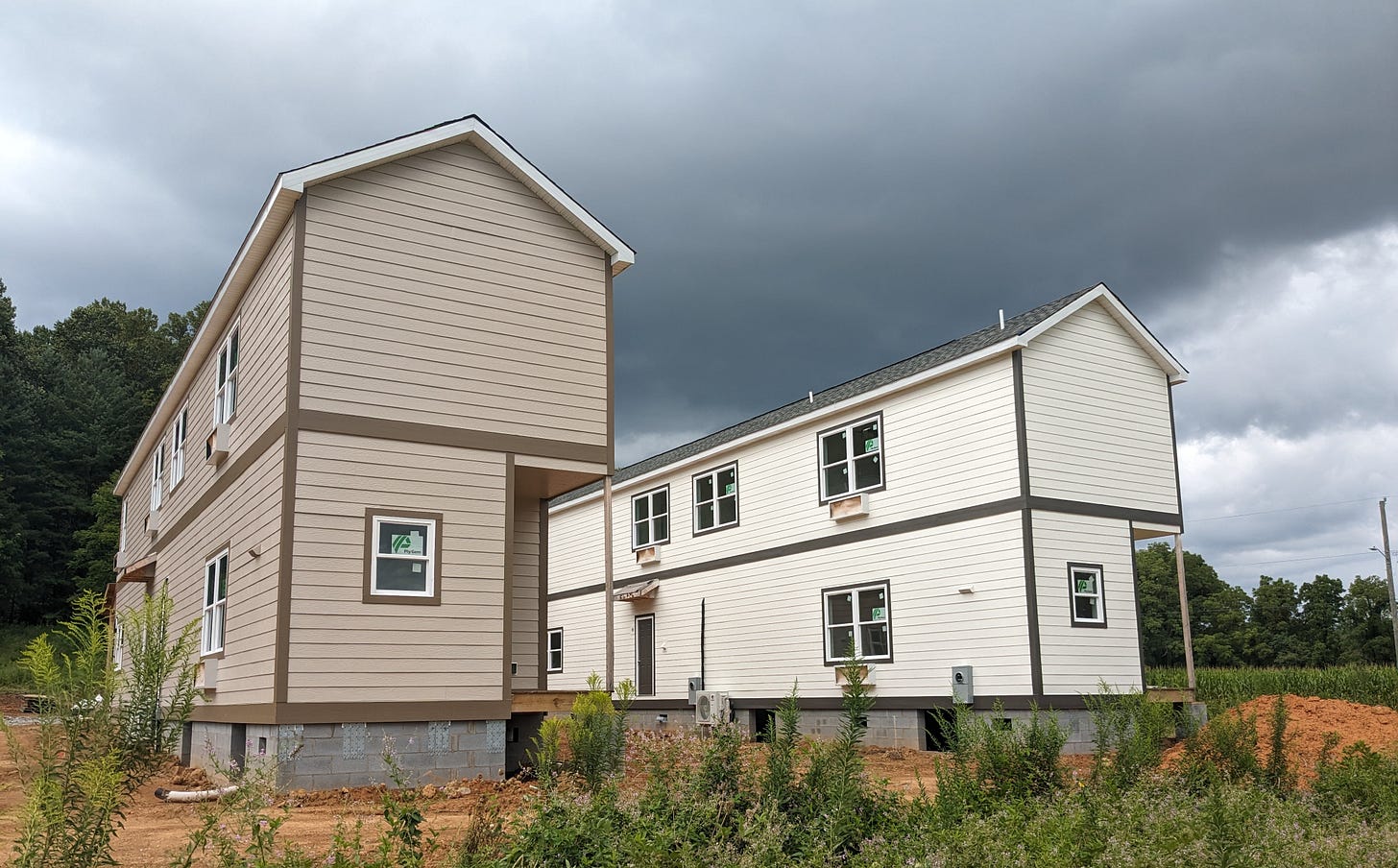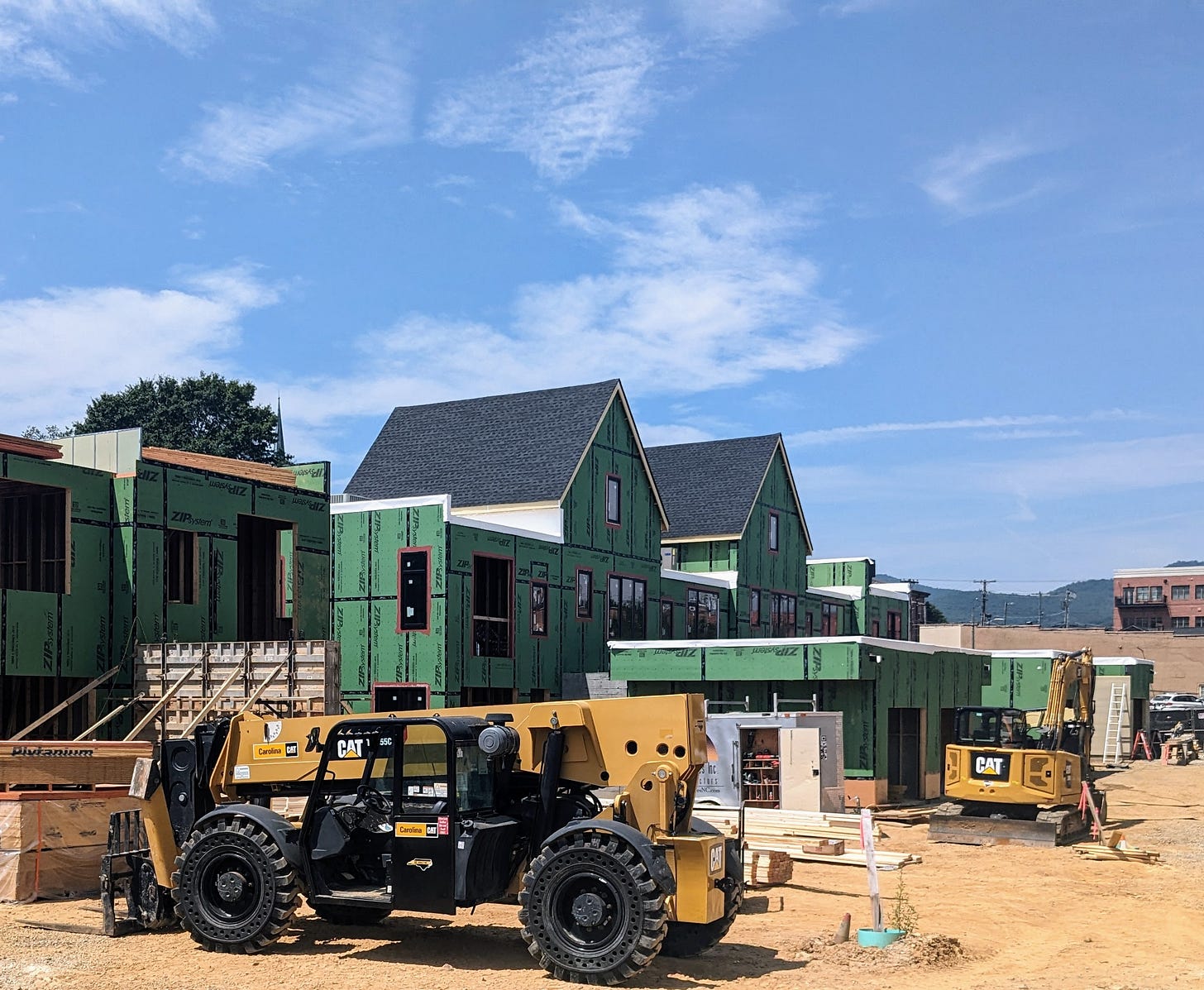Filling "Missing Middle" Might Ease Brevard's Affordability Crunch, but is Far from a Cure
Small multi-family projects should relieve some demand for housing. But, in most cases, their prices are beyond the reach of working residents, showing the need for city affordability efforts.

BREVARD — Bulldozers and cranes. Raw earth in newly graded lots. Framed walls, insulation boards, fresh vinyl siding.
Such sights have appeared in downtown Brevard and in the historically African-American community of Rosenwald, off Old Hendersonville Highway and Asheville Highway.
They are signs not just of continued busy residential construction in Brevard, but of the dense development the city is trying to encourage.
Specifically, these duplexes, townhouses, condominiums and small apartment complexes are examples of the “missing middle,” described in the city’s newly adopted Comprehensive Land Use Plan as projects that “fall somewhere between the detached single-family residence and the mid-rise apartment buildings.”
Filling this gap is especially crucial in Brevard, where the shortage of large developable lots places a premium on creating small pockets of high-density. This will add variety to city housing stock dominated by land-eating single-family homes and start to ease the crushing demand that has led to soaring housing costs.
But as welcome as these projects are, they also highlight the need for the city’s ongoing initiatives to promote affordable housing.
None of the multifamily projects now being built received government subsidies and none are required to offer affordable or workforce housing. Most of their units will likely be far out of the price range of wage-earning city residents.
“The argument has been made — let the market take care of it,” Mayor Pro Tem Gary Daniel, chairman of the City Council’s Housing Committee, said of the city’s affordability crisis, “but I think it’s clear the market is not going to take care of it.”
Which is why the Brevard City Council has made affordable housing its top priority.
When adopting its new budget this summer, the Council devoted property tax revenue to the city’s Affordable Housing Trust Fund for the first time, and it will soon consider ordinance changes designed to “right size” parking in the city, a city planner said — one of several potential moves to add flexibility to rules that can stand in the way of building dense units at lower cost.
The Council recently limited the creation of new short-term rentals, which have been blamed for consuming spaces that could house working residents, and it hired an arm of North Carolina University Chapel Hill’s School of Government to assess the (very acute) local need for affordable housing and identify sites for projects that could ease this shortage. In 2022, it voted to allow triplexes and fourplexes in zones previously restricted to single-family homes.
If these seem like piecemeal measures, they are, said City Planning Director Paul Ray, because that’s the only way local governments can take on an issue as complicated as affordable housing.
“It has to be done incrementally. All of it added together moves the needle,” Ray said. “There is no silver bullet.”
Easing Pressure
The developers behind the new projects are familiar in local planning circles.
Travis Fowler’s First Victory Inc. has previously completed two multi-family projects in Brevard and is now building a cluster of three apartment buildings called Ecusta View Commons near a new roundabout on Asheville Highway north of downtown. The buildings will contain a total of 18 two-bedroom units.
The company is also set to begin work on Carver Street Commons, which will include as many 22 condominiums, some in a mixed-use building with space for a restaurant, in the Rosenwald neighborhood.
George Lenze, known for building single-family homes on small infill lots in the city, is behind the Jordan Street Townhomes off East Main Street in downtown. It includes the nine townhouses now taking shape on East Jordan Street, and though plans for the rest of the project are not yet set, Lenze said, it should include live/work units facing South Johnson Street and, later, mixed-use structures facing Main.
Tore Borhaug, a longtime advocate of workforce housing, is building a series of duplexes called the Osborne Road Subdivision, which is designed to be accessible to employees of his Tore’s Home assisted living facilities. The exteriors of two of the buildings appear to be nearly complete. He has permits to build six more duplexes, and the subdivision’s four-acre parcel near Osborne and Old Hendersonville has room for future phases, Ray wrote in an email.
Though the current zoning of most of these locations does not allow single-family home construction, that has long been the dominant form of housing in the city and accounts for about 70 percent of Brevard’s residential units, according to the Comprehensive Plan.
To see the benefits of small-parcel, missing-middle projects, said Council Member Aaron Baker, imagine the alternative:
“Three or four single family homes and those homes selling for hundreds of thousands of dollars, $800,000 to $1 million,” Baker said. “I don’t think it’s really accurate to say that dense development is not having an impact on affordable housing.”
Without additional housing capacity, the price of current low-cost units will be pushed upward, said Emily Brewer, a senior planner at the city, and the seeds of this trend can be found in the report from the School of Government’s Development Finance Initiative (DFI), which was delivered to the city in July.
Because of Transylvania County’s near-zero rental vacancy rates, the report said, more than 45 percent of the county’s affordable units are occupied by renters with higher incomes.
“Anything we can do to diversify the housing stock can take pressure off some of the more affordable properties,” Brewer said.
“We need it all,” Ray said. “We need what First Victory is doing and we need a lot of deeply affordable units too.”
“Not Affordable”
How many? That was also documented in the July report.
More than 800 low-to-moderate income families in Brevard are in need of housing, said the study, which also detailed the reliance on low-wage service jobs and soaring housing costs propelling this demand.
Half of Transylvania’s workers are employed in industries such as retail that pay an average of less than $40,000 per year, the report found; the average price of a new home, on the other hand, more than doubled between 2016 and 2022 to $633,000.
Most workers in Brevard can’t come close to affording such a price, according to information Brewer presented to the Council in March.
Workforce housing units are defined as affordable to families earning between 80 and 120 percent of a community’s median income. In Brevard, that means monthly rents or home payments topping out at $1,669, Brewer’s report said.
To qualify as affordable housing — consuming less than 30 percent of the earnings of families making up to 80 percent of the area median income — rental units must go for no more than $1,191.
Lenze does not know how much he’ll ask for his townhouses, he said, but additional construction costs such as code-required fire walls between units will likely push prices near those of his single-family homes, which have historically sold for well over $500,000.
“I don’t anticipate a great difference even though this is a townhome development,” he said.
The units at Ecusta Commons are nearly identical to those at the existing First Victory complex on Colwell Drive in Brevard but offer more amenities — a fitness center and storage units, Fowler said. An online listing said one of the Ecusta units would be available for $2,050 per month, not including utilities.
When told of that price, Daniel said flatly, “That’s not affordable.”
Of the four developments listed above, only the Osborne Road subdivision has been touted as offering low-cost units. Borhaug has told city planners the subdivision is designed to house workers, primarily the ones at his facilities, but he declined to provide projected rents to NewsBeat.
A neighbor who opposed the rezoning that allowed the development said whatever those price points, they will be reached by relying on modular construction and skimping on beautification. (Borhaug, who declined to be interviewed, wrote in an email that he plans to add landscaping that will meet city requirements.)
“It’s not aesthetically pleasing,” the neighbor, Angela Pacey, said of the nascent complex. More significantly, she said, Borhaug is under no obligation to rent to workers or contain prices.
“If the employees do not choose to live there, he can rent to anyone and he can charge anything he wants,” she said.
Another neighbor who spoke out against the zoning change, David Nielsen, argued against the very idea that dense development will control housing costs.
“Affordable housing is just a foot in the door for developers. Once they are up and running they are slaves to the market,” Nielsen, a builder, said at a Council meeting in June.
“Simply creating more housing will not solve the affordability crisis.”

Bonuses
True, Fowler said, but that crisis is driven mostly by costs to developers, who must show higher sale prices and rents to receive financing for ever-more expensive projects.
Case in point, he said, the Carver Street job was put on hold for nine months while he sought to secure a federal permit to raise a portion of the property out of the flood plain — a costly delay extended because the permitting agency “moved their office and didn’t notify anyone,” he said.
“That’s just a simple example of the ridiculous stuff that happens. That property should already be built and partially occupied and we’re just getting started on it now.”
At Ecusta Commons, he was required to build a new city road, Maple Grove Lane, that added to other, well-publicized costs of building in the post-pandemic era.
“Financing is very, very difficult and of course, construction is super expensive,” he said.
The city recognizes such obstacles, Ray and Brewer said in an interview last week, and outlined strategies to reduce the cost of market-rate projects and encourage more designated affordable housing.
The changes to the parking requirements, which received the backing of the city’s Planning Board last month, are intended to allow developers to devote more space to housing and less to parking where appropriate. Fewer spaces might be needed, for example, in parts of town with access to plentiful public parking.
“It’s a very nimble ordinance,” Ray said.
The Comprehensive Plan highlighted other potential changes to the city’s Unified Development Code (UDO) that could cut costs and encourage density.
The Plan tacitly discourages a tactic commonly used in other states, mandatory inclusionary zoning, which requires developers of multi-family projects to reserve a percentage of new units for workforce or affordable housing. Such rules have been challenged in North Carolina, the Plan says, and under state law, lie in a “legal gray area.”
But similar results can be achieved without the threat of legal battles by offering incentives for developers to add lower-cost units, the Plan said.
These might include relaxing height and setback requirements or offering “density bonuses” to allow more revenue-generating units on the same amount of land.
Brewer said planners won’t move forward with incentives before they gather more information from developers about which ones would be most effective. But initial conversations, Ray said, have revealed interest in the bonuses.
“What we want to say is, ‘Hey, if you want to build 50 units in our city, the zoning district you’re in right now doesn’t support that . . . but you could claw back some density if three of (the units) are affordable,’ and they say, ‘Oh, tell me more about that.’ ”
The (Eventual) Promise of Cash
Fowler and Lenze commended these efforts.
“Paul (Ray) and his office, and the mayor’s office, are very active in trying to figure this out,” Fowler said.
But he and others brought up continued obstacles that, Ray said, simply confirm his main points: Tackling the affordable housing crisis will take time and cannot be solved with a single initiative.
Adding flexibility to parking requirements, for example, sounds promising, Fowler said, but its impact will be limited by demands of lenders and buyers who expect to see plenty of dedicated spaces. Density bonuses bring up the same issue. Building more units on less land would be great, he said, but where are developers going to put parking?
“Not allowing the people to have a place to park is going to cause you to have vacancies, and that’s not going to work,” he said.
Daniel raised another concern about the bonus idea. The strategy of offering incentives to add a percentage of low-cost units, he said, typically applies only to large developments on large lots, which are notoriously hard to come by in a city hemmed in by mountains and the flood-prone French Broad River.
Of the three parcels examined in the DFI report, for example, one on Cashiers Valley Road is owned by the city and would probably be available for use by a willing developer of affordable housing. But steep slopes and a power line easement leave only a small portion of its eight acres suitable for construction.
Another of the tracts — a four-acre plot occupied by the U.S. Army Reserve on French Broad Street near downtown — could be a “prime” property for affordable housing, Ray said, but its owners have told him it will be unavailable for at least another five years.
None of this means that that the city’s efforts are for naught, he said. The idea is that incremental code adjustments can combine to encourage creative solutions such redevelopment of underused property.
But he also acknowledged that the need for patience applies even to the Council’s most dramatic commitment to containing housing costs, devoting two cents of property tax to the Affordable Housing Trust Fund.
That will amount to about $264,000 this year and in the coming years the accumulated sums should allow significant investments in affordable housing.
The Council, for example, could eventually tap into this account to pay for land acquisition, site preparation or closing “funding gaps” such as the one that has emerged at Fairhaven Meadows, a 60-unit apartment complex planned for 4.6 acres off Asheville Highway.
It’s the only planned multifamily project in the city not in the missing middle, the only one that can directly address the affordability crisis. It’s exactly the kind of project the Fund was designed to help, Ray said.
Last October, Fairhaven’s developer, Commonwealth Development Corp., was awarded federal low-income tax credits and said that it would offer Fairhaven apartments at rents affordable to families earning between 40 and 70 percent of the county’s annual median household income.
The problem, said Mayor Maureen Copelof: the cost estimates used to receive this award were submitted in January of 2022, and “now that it’s September of 2023, those costs are so much higher.”
In a recent meeting with a representative of Commonwealth, Copelof said, she pledged to reach out to the state agency that distributes federal housing funds in North Carolina. She’s hopeful, she said, because the pinch of rising construction costs are undoubtedly being felt by similar projects. “I’m sure they (Fairhaven’s developers) are not unique,” she said.
Can money from the Fund close this gap? Not by much, Paul said, at least not now.
“The Affordable Housing Trust Fund is in its infancy,” he said. “I don’t think we’re going to be putting down a lot of money for this project.”
Email: brevardnewsbeat@gmail.com





While I agree, with the overall discussion about lack of affordable housing in Brevard, there are some concerns: Do we really need super dense development that will change this small city feel into a burgeoning suburb? Can Brevard’s public services (roads, police, fire, hospitals, schools, sewer and water supply) handle a massive increase in year round residents without a major tax increase on real estate? Will current residents be able to review detailed information from developers about their proposals & potential impacts? With a fast influx of new residents, can the city cope with the inevitable increase in crime?
Hello, this Ken again. Is anyone there?